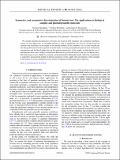Symmetric and asymmetric discrimination of bosonic loss: Toy applications to biological samples and photodegradable materials
Author(s)
Pirandola, Stefano; Braunstein, Samuel L.; Spedalieri, Gaetana
DownloadPhysRevA.98.053836.pdf (1.318Mb)
PUBLISHER_POLICY
Publisher Policy
Article is made available in accordance with the publisher's policy and may be subject to US copyright law. Please refer to the publisher's site for terms of use.
Terms of use
Metadata
Show full item recordAbstract
We consider quantum discrimination of bosonic loss based on both symmetric and asymmetric hypothesis testing. In both approaches, an entangled resource is able to outperform any classical strategy based on coherent-state transmitters in the regime of low photon numbers. In the symmetric case, we then consider the low-energy detection of bacterial growth in culture media. Assuming an exponential growth law for the bacterial concentration and the Beer-Lambert law for the optical transmissivity of the sample, we find that the use of entanglement allows one to achieve a much faster detection of growth with respect to the use of coherent states. This performance is also studied by assuming an exponential photo degradable model, where the concentration is reduced by increasing the number of photons irradiated over the sample. This investigation is then extended to the readout of classical information from suitably designed photodegradable optical memories.
Date issued
2018-11Department
Massachusetts Institute of Technology. Research Laboratory of ElectronicsJournal
Physical Review A
Publisher
American Physical Society
Citation
Spedalieri, Gaetana et al. "Symmetric and asymmetric discrimination of bosonic loss: Toy applications to biological samples and photodegradable materials." Physical Review A 98, 5 (Naovember 2018): 053836 © 2018 American Physical Society
Version: Final published version
ISSN
2469-9926
2469-9934